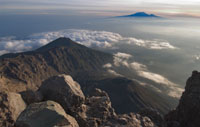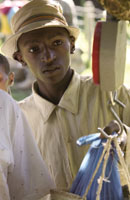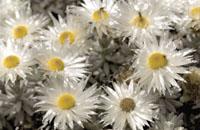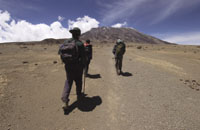|
Features
How To: Two Weeks, Two Peaks
Tips and tricks for those once in a lifetime shots.
By Jon Cox
Two weeks may seem like a long time with countless photo
opportunities, but when you are trekking up the highest mountain
in Africa the time goes by quickly. I was on Safari for three weeks
teaching photography and wildlife conservation and at the end of
the three-week safari I stayed behind to hike Mt. Kilimanjaro. It
was my fourth trip to Africa and I just couldnāt pass up the chance
to see the icy peak before all of the glaciers melt. Just like I
relied on my porters and guides to lead me to the summit, I also
relied on a variety of digital camera equipment to get the most
out of my travel photos. In the past, when hiking throughout the
United States, Iāve always carried all of my own food, clothing
and camera. Hiring a few extra hands, while supporting the local
economy, allowed me to carry more camera gear than I would normally
take and increased my photo opportunities.
 Meru
Peak Meru
Peak
Photographing the rising sun over Mt. Kilimanjaro, many kilometers
from the peak of Mt. Meru, meant getting up at midnight and hiking
by the light of the moon. As luck would have it, we reached the
14,979-foot peak just in time to see the majestic mountain silhouetted
by a brilliant sky. (To capture rocks in the foreground, the crater,
the clouds below and Mt. Kilimanjaro in the distance I used my 12-24mm
wide-angle lens.) A tripod was essential to steady the camera while
I used a long shutter speed of 20 seconds enabling me to use a high
f/stop of f/22 to show the foreground and background in sharp focus.
 Sunrise Sunrise
Hanging moss is one of natureās delights. You can use the moss as
a natural frame, a close-up or to add mystery to a scene. My 80-400mm
zoom lens was the perfect tool allowing me to sneak a peak of the
rising sun through a clump of hanging moss off in the distance.
If I didnāt have this long zoom there is no way I could have filled
the frame.
 Porter
Images Porter
Images
Porters are the foundation of climbing Mt. Kilimanjaro in Tanzania.
If it wasnāt for the local porters and guides most tourists like
myself would never reach the roof of Africa. Porters and guides
are some of the most fascinating people, telling countless stories
of storm and wildlife encounters. My favorite piece of equipment
for shooting people is my 105mm lens. This lens provides plenty
of working distance, but still allows me to make a personal connection
with my subject. Since itās equipped with a low f/stop of f/2.8,
itās easy to separate your subject from the background because of
the low depth of field it offers.
Rainforest
Image
Hiking
up Mt. Kilimanjaro and Mt. Meru gives you the chance to see a variety
of biomes in a short period of time. One of the most important things
to remember when traveling is to take the shot when you can, even
if it means unpacking all of your camera gear to get the right lens.
The soft diffused light falling on this scene changed in a matter
of minutes.
 Alpine
Flowers Alpine
Flowers
Tourists
often neglect macro shots. After all, what usually attracts us to
travel to a place is the landscape. A lunch break or a short rest
is the perfect to time to take advantage of the close-up world.
You can change almost any lens into a macro lens by adding a close-up
filter or by utilizing the macro mode built in to your camera. Either
way, make sure you look down once in a while so you donāt miss out
on some great close-up opportunities.
 Hiking
the saddle Hiking
the saddle
High noon is one of my least favorite times to take photographs,
but I wanted a full frontal view of Mt. Kilimanjaro and this was
the only possible time in which to take my shot. Using a wide-angle
lens enabled me to capture hikers and the receding glaciers the
day before we hiked to the peak, 19,340 feet. Even if the light
may not seem ideal, take the shot. You may not get another. One
of the highlights of my trip was talking with Jibson, our 67 year-old
guide. Jibson said, ćI remember when the glaciers covered half of
the mountain but now they are melting fast and soon they will be
gone.ä
-Jon
Cox is the author of Digital Nature Photography and teaches photo
workshops in Chesapeake City Maryland www.horizoncreativeescapes.com.
Home
|



 Meru
Peak
Meru
Peak
 Sunrise
Sunrise
 Porter
Images
Porter
Images
 Alpine
Flowers
Alpine
Flowers
 Hiking
the saddle
Hiking
the saddle